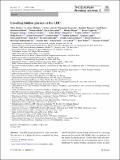Unveiling hidden physics at the LHC
Author(s)
Fischer, Oliver; Mellado, Bruce; Antusch, Stefan; Bagnaschi, Emanuele; Banerjee, Shankha; Beck, Geoff; Belfatto, Benedetta; Bellis, Matthew; Berezhiani, Zurab; Blanke, Monika; Capdevila, Bernat; Cheung, Kingman; Crivellin, Andreas; Desai, Nishita; Dev, Bhupal; Godbole, Rohini; Han, Tao; Harris, Philip; Hoferichter, Martin; Kirk, Matthew; ... Show more Show less
Download10052_2022_Article_10541.pdf (4.502Mb)
Publisher with Creative Commons License
Publisher with Creative Commons License
Creative Commons Attribution
Terms of use
Metadata
Show full item recordAbstract
Abstract
The field of particle physics is at the crossroads. The discovery of a Higgs-like boson completed the Standard Model (SM), but the lacking observation of convincing resonances Beyond the SM (BSM) offers no guidance for the future of particle physics. On the other hand, the motivation for New Physics has not diminished and is, in fact, reinforced by several striking anomalous results in many experiments. Here we summarise the status of the most significant anomalies, including the most recent results for the flavour anomalies, the multi-lepton anomalies at the LHC, the Higgs-like excess at around 96 GeV, and anomalies in neutrino physics, astrophysics, cosmology, and cosmic rays. While the LHC promises up to 4
$$\hbox {ab}^{-1}$$
ab
-
1
of integrated luminosity and far-reaching physics programmes to unveil BSM physics, we consider the possibility that the latter could be tested with present data, but that systemic shortcomings of the experiments and their search strategies may preclude their discovery for several reasons, including: final states consisting in soft particles only, associated production processes, QCD-like final states, close-by SM resonances, and SUSY scenarios where no missing energy is produced. New search strategies could help to unveil the hidden BSM signatures, devised by making use of the CERN open data as a new testing ground. We discuss the CERN open data with its policies, challenges, and potential usefulness for the community. We showcase the example of the CMS collaboration, which is the only collaboration regularly releasing some of its data. We find it important to stress that individuals using public data for their own research does not imply competition with experimental efforts, but rather provides unique opportunities to give guidance for further BSM searches by the collaborations. Wide access to open data is paramount to fully exploit the LHCs potential.
Date issued
2022-08-03Department
Massachusetts Institute of Technology. Center for Theoretical PhysicsPublisher
Springer Berlin Heidelberg
Citation
The European Physical Journal C. 2022 Aug 03;82(8):665
Version: Final published version